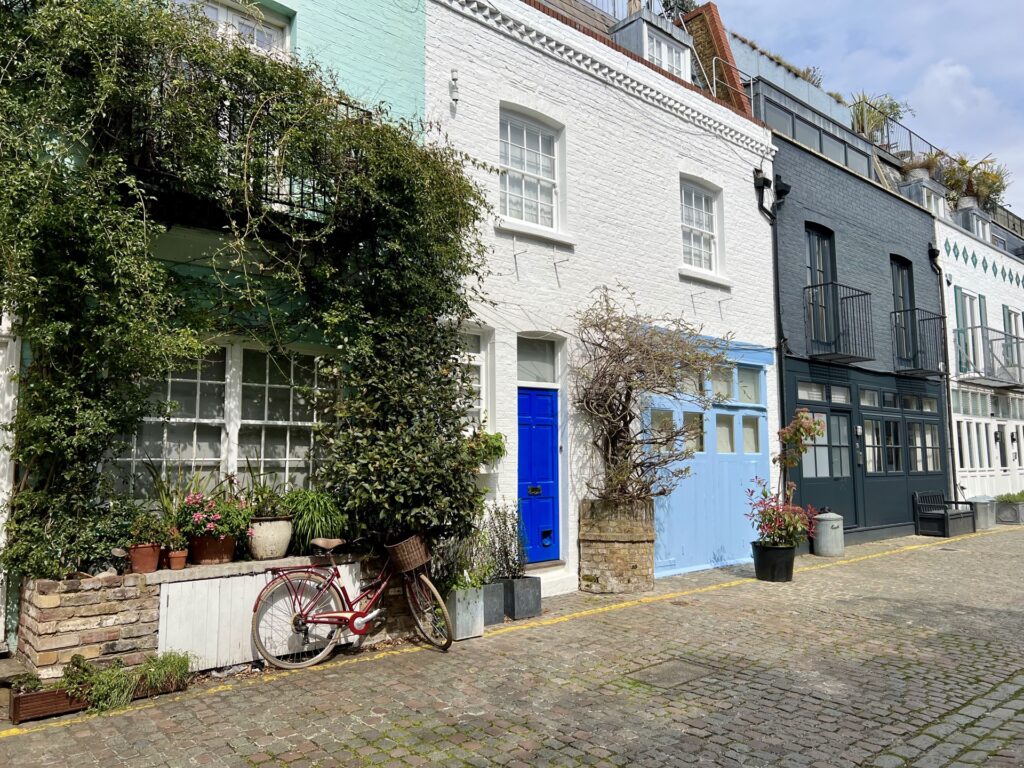Notting Hill is one of the most famous neighborhoods in London. Despite its long and oscillating history, it seems as though Notting Hill is most commonly associated with the 1999 film by the same name. Having not seen the film and not understanding the draw of the neighborhood, I never prioritized this part of West London during any of my previous London trips.
That finally changed in 2023. Having already canvassed a good chunk of this great city, I decided it was finally time to get to Notting Hill. I watched the movie on my flight to London and liked it enough. I figured I’d see Portobello Market and pay homage to the bookshop and carry on.
What I didn’t know was how hard and how fast I was going to fall in love with this little corner of London. I didn’t realize how much more there was to Notting Hill than a couple of film spots. And while Notting Hill is a far cry from a hidden gem, it felt like one to me.
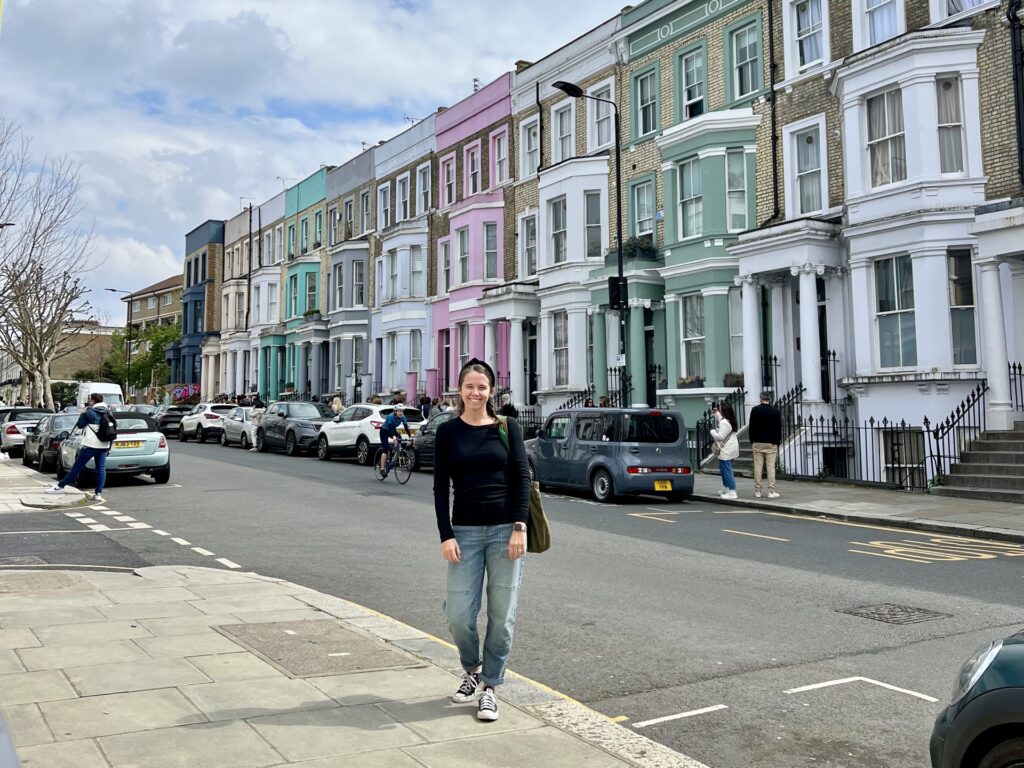
I’m excited to share my journey through Notting Hill! I’ll cover everything from the Tube ride there, my exact walking route and everywhere I stopped along the way. I hope you find this neighborhood as delightful as I did, though I’m nearly certain you will.
A Brief History of Notting Hill
The story of Notting Hill is a familiar tale of gentrification — a delicate scale that easily tips by the imbalance of income and race equality.
Notting Hill has no formal boundaries and no official founding date, but the area first became known as Notting Hill sometime in the late 1800s. Large houses were built in the area with the hopes of luring London’s elite to this part of West London, but the elites never came. By the early 1900s, the larger homes were broken up into multi-family housing. The smaller homes were more reasonably priced and attracted an influx of immigrants (particularly from the Carribbean) and the working class.
Much of Notting Hill was destroyed during WWII, and what remained fell into slums. Landlords at the time became infamous for their treatment of tenants and the neighborhood became the center of several race riots. In the 1960s, the Notting Hill Housing Trust was formed, which was responsible for clearing the slums, enforcing building codes, and improving the status of the neighborhood. To that end, the trust was successful.
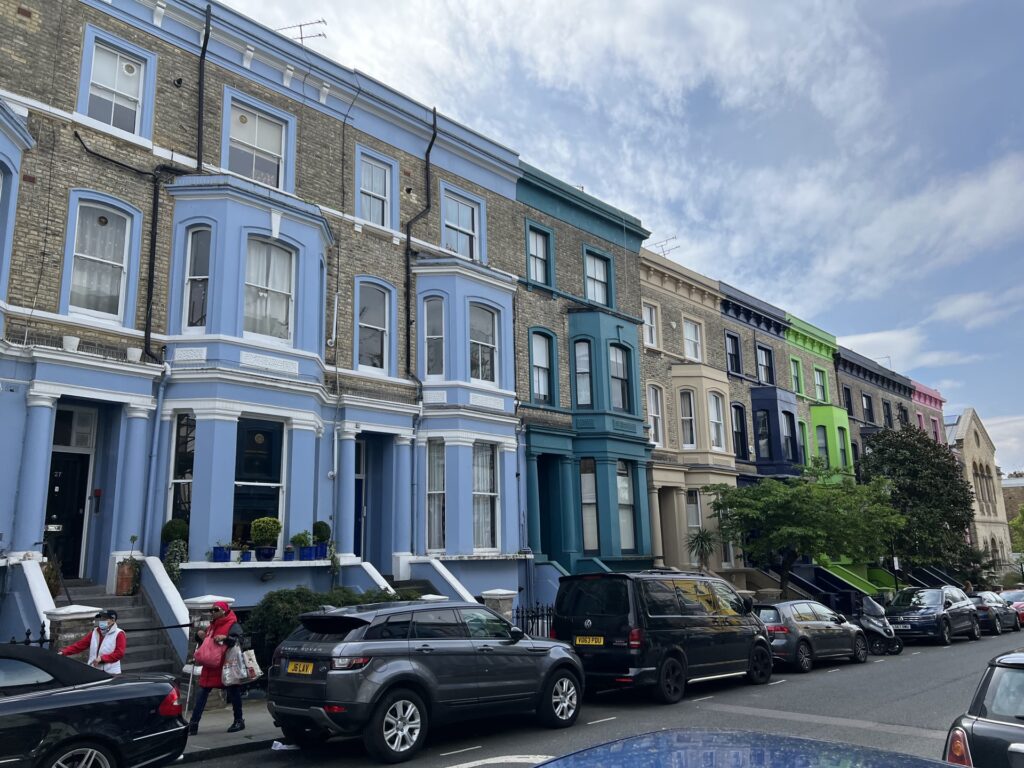
This renovation attracted wealthier tenants who could afford and were actually interested in the larger single family homes of the area. By the late 1960s, Notting Hill was already attracting celebrity attention — Mick Jacker bought his famous red jacket there, The Beatles recorded part of a music video there, and eventually, the film Notting Hill was made in 1999. Notting Hill became one of the most desirable and wealthiest areas in all of London.
Tourism in Notting Hill surged in response to the film and continues today. The colorful streets have also made it a popular destination for photographers and influencers. The crowds have helped keep the neighborhood lively, but not without a cost. Rising rents forced out many of the local shops, including the original The Travel Bookshop that inspired the film.
While gentrification has change the neighborhood, it wears its scars with pride. Notting Hill is as beautiful as ever, with winding streets, eclectic shops and colorful facades. The Caribbean roots are still evident in the annual Carnival festival and street food vendors on Acklam Road. And of course, the famous Portobello Road Market is livelier than ever, just like its been since the 1860s.

Getting to Notting Hill on the Tube
Like all good things in London, my journey began on the Tube. For this particular trip, I was staying at The Montcalm Royal London House. (I was in town for the London Marathon, for which it was the perfect central location.) Fortunately for me, that location was also perfect for getting to Notting Hill on a single train ride.
I took the Central line to Notting Hill Gate station, which also serves the District and Circle lines. There are a few Notting Hill Tube stations, but this seemed like the best one. (We also have a full guide explaining exactly how to use the London Underground if you want to learn more.)
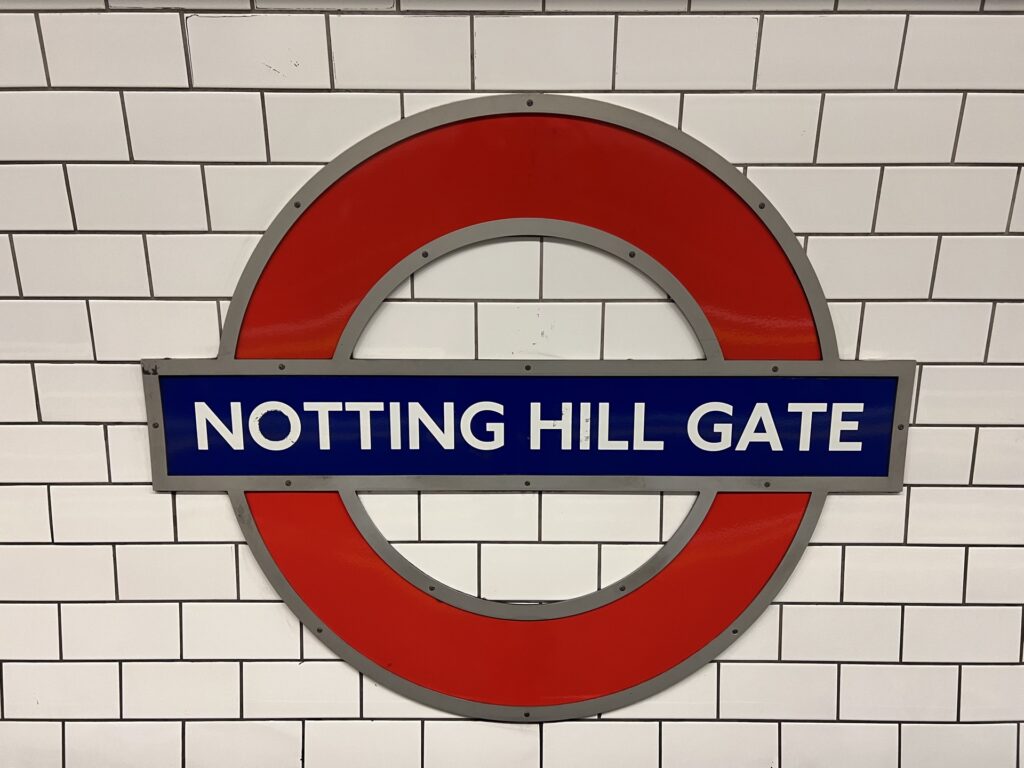
Fun Fact! Notting Hill Gate used to be an actual gate where tolls were collected. Today, Notting Hill Gate just refers to a portion of a relatively uninteresting street. You can read more about it here.
From the station, I walked north on Pembridge Road and was immediately smitten. This stretch of road started with a colorful collection of cafes and bakeries, then it bent through a residential neighborhood lined with trees and full of beautiful houses. The road eventually gave way to Westbourne Grove, a commercial shopping and dining street filled with upscale restaurants and high-end shops.
I made this walk relatively quickly because I was on a mission.
Breakfast at Sunday in Brooklyn
I had been dreaming about eating at Sunday in Brooklyn in Notting Hill for the better part of a year and made my reservation as soon as they opened up a month in advance. In fact, this restaurant is one of the main reasons that I prioritized getting to Notting Hill at all!
You might be thinking, “But Emily, there are so many great restaurants in Notting Hill. Why would you pick a restaurant that also has a location in NYC where you live?” Great question!
Well, the truth is that it is easier for me to go to this restaurant in London on a trip I already had scheduled, than it was for me to get from my apartment in Queens to the restaurant’s NYC location in Williamsburg. It’s true! The first Google Map recommendation suggests a route with three trains and a bus, taking 50 minutes.
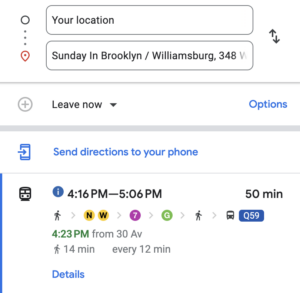
Anyway, this is the restaurant I picked and it was a good one! I was glad I had a reservation, because the restaurant was packed on a Saturday morning. In fact, all of the restaurants on this street were packed on a Saturday morning.
Sunday in Brooklyn in Notting Hill was just as lovely and delicious as I hoped it would be. The decor was airy and light and dripping with greenery and fairy lights. I got a cappuccino and a delectable avocado toast, but the true highlight was their iconic and massive Hazelnut Maple Praline pancakes.
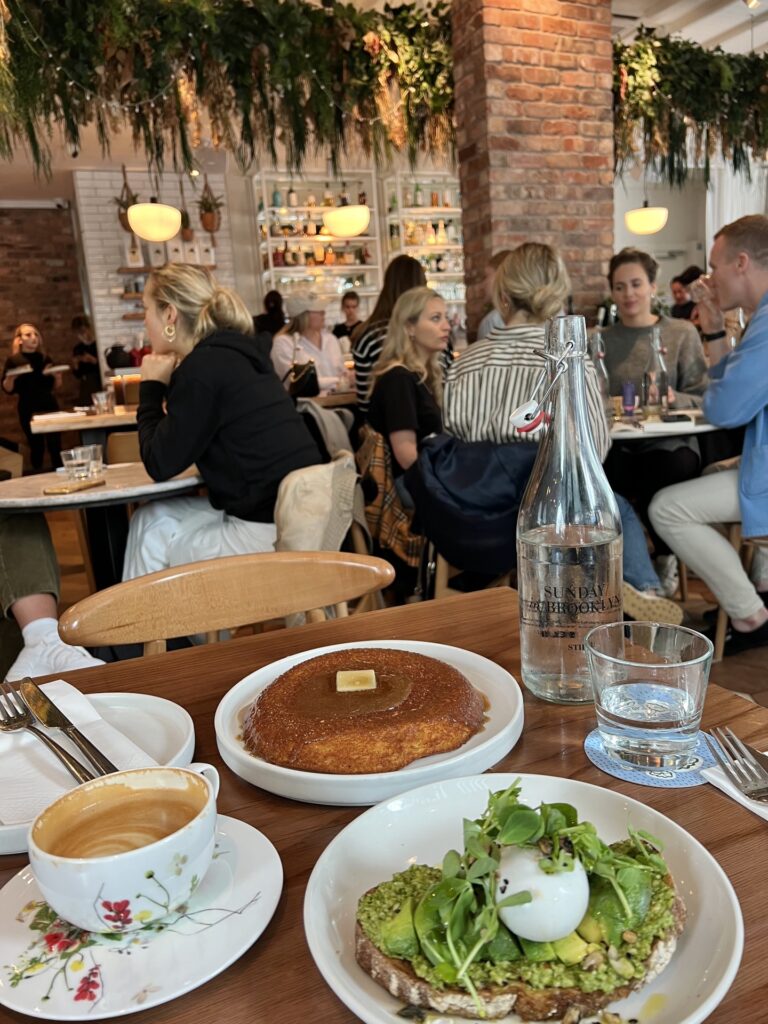
Whether you’re in Brooklyn or London, Sunday in Brooklyn is not to be missed!
Coffee & Stroll on Westbourne Grove
Now it was time to explore! When I walked out of Sunday in Brooklyn, I was right in the middle of Westbourne Grove. It’s a colorful commercial thoroughfare, lined with busy cafes and a wide array of shops. On a weekend, this strip was lively without being overcrowded, with a mix of locals and tourists.
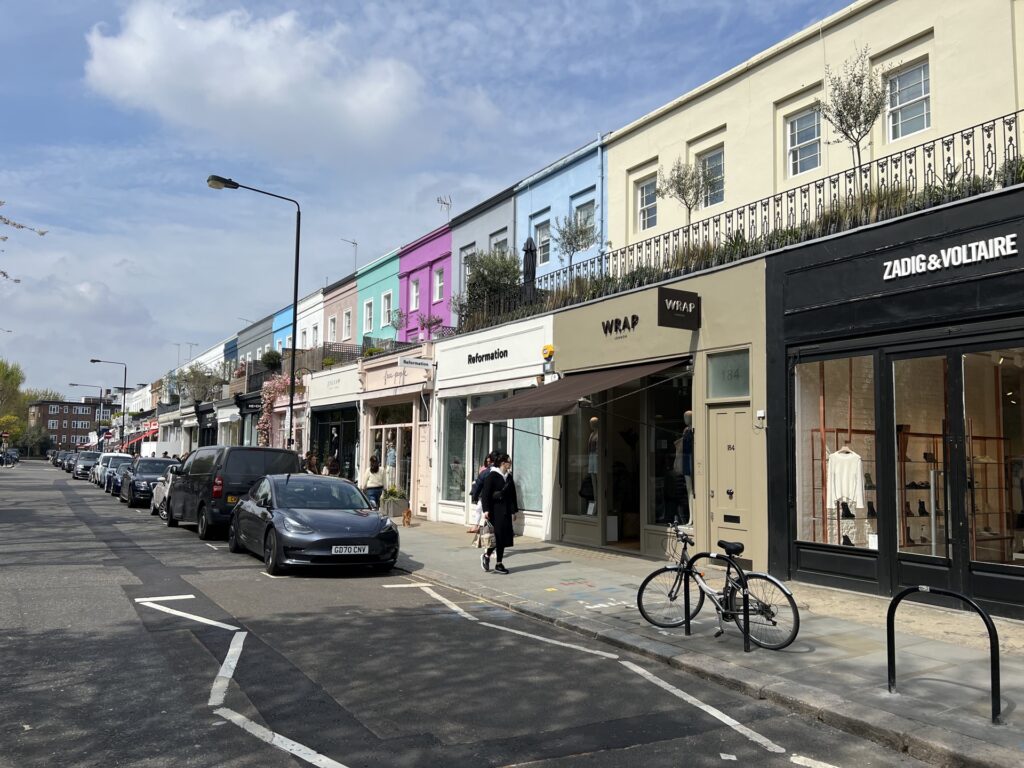
My first stop was coffee. (If I have an American trait, it’s a need to be carrying a coffee every time I step outside.) I followed Westbourne Grove east to a London-based coffee shop called Arro. I ordered an Americano — my default and uninspired coffee order abroad — and wistfully eyed the pastry case. It was a cute cafe, with a lovely elevated seating area. I had a lot more to see so I took my coffee to go, and headed back west down Westbourne Grove.
I was happy with my choice, but I quickly discovered that Notting Hill is not short on coffee shops! On my way to Arro, I passed L’Etoile which looked like the perfect place to sit down with a coffee. Then I discovered another hidden gem: Hagen Espresso Bar. I had searched “coffee” in Google Maps a hundred times and it never came up, even though the sign clearly says they have the best coffee in town!
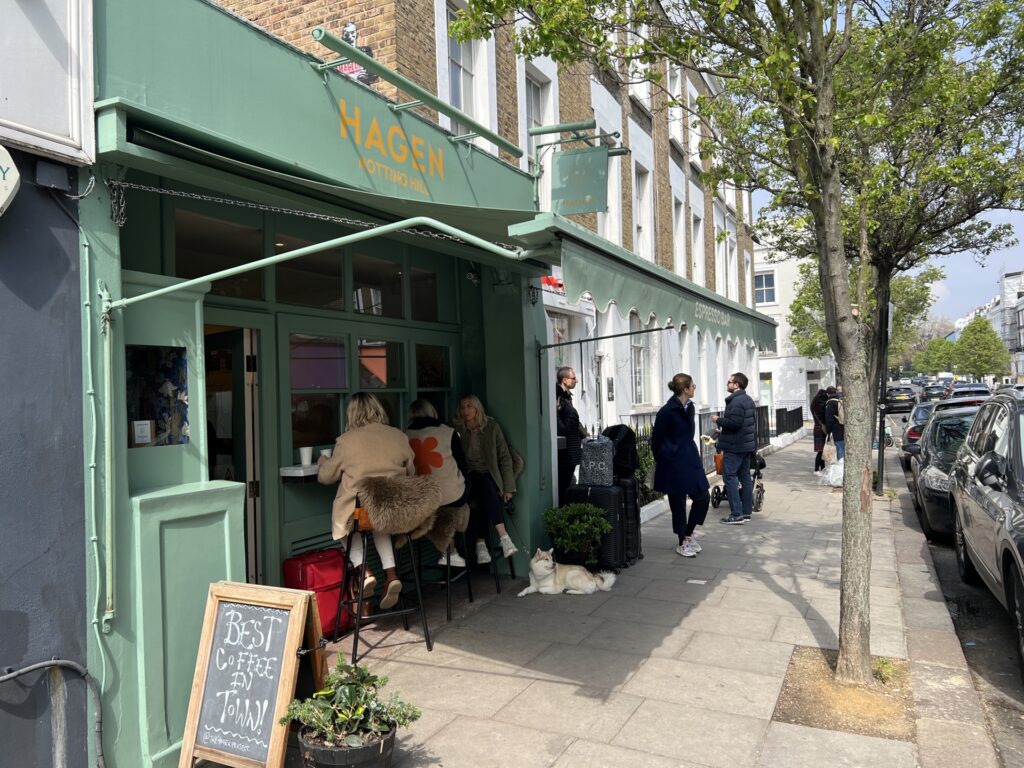
I walked down Westbourne Grove all the way from Arro to Portobello Road, taking a few detours along the way. The area just north of Westbourne Grove is mostly residential, and was filled with pastel homes and tree-lined streets. I’d definitely recommend veering off the main path if you have some time. Specially, I really enjoyed walking north a few blocks on Colville Road, Ledbury Road and Artesian Road.
Portobello Road Market
As I approached the end of Westbourne Grove, it was impossible to miss Portobello Road. On a Saturday afternoon, the Portobello Road Market had fully taken over the street and was packed with vendors and shoppers. The market takes place every day except Sunday, and it’s busiest on Saturdays — which I can confirm.
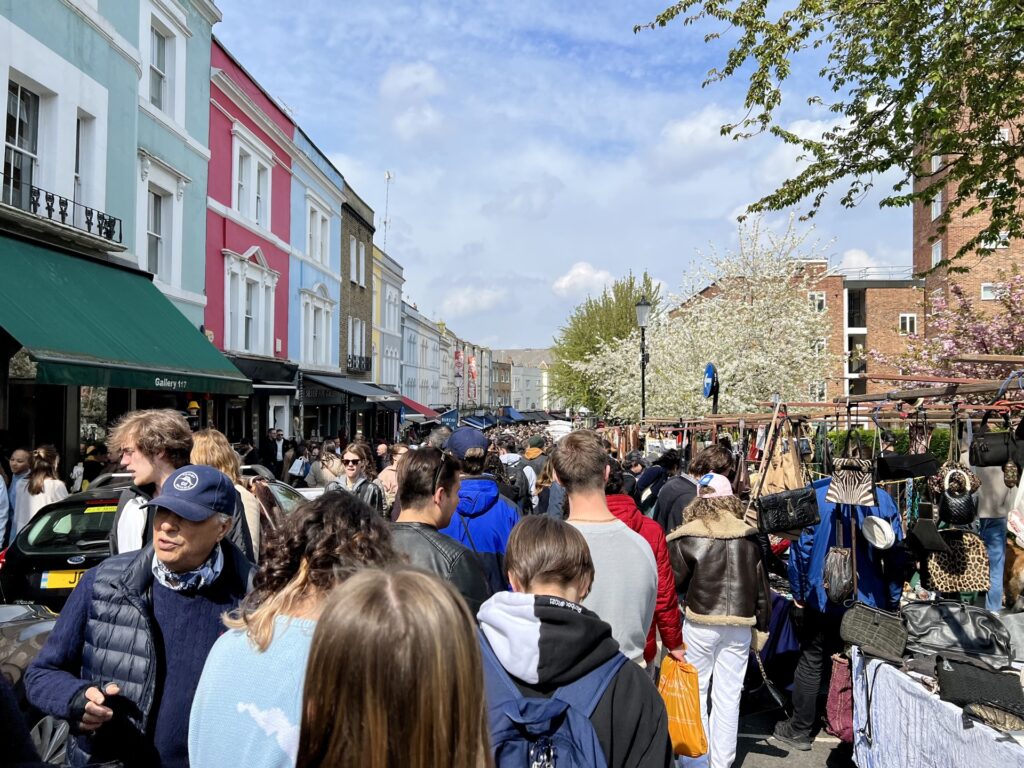
When I say that the market has everything, I’m not being dramatic. I saw antiques, new and vintage clothing, kitchenwares, handmade jewelry, kitschy souvenirs, fresh produce, delicious street food, and so much more. In addition to the street stalls, the road itself was also lined with shops, cafes and pubs, that are all equally lively during market hours. My favorite find was a cookie shop called Biscuiteers, which had the most exquisitely decorated sugar cookies.
The market is divided into a few different sections. Most of the main vendor stalls are located on Portobello Road between Westbourne Grove and the underpass at Westway. Portobello Road on the south end has several antique shops, but not market stalls. On the other end beyond the overpass, there is a bustling street food market, and then vendors become less dense and are primarily vintage/antique/bric-a-brac.
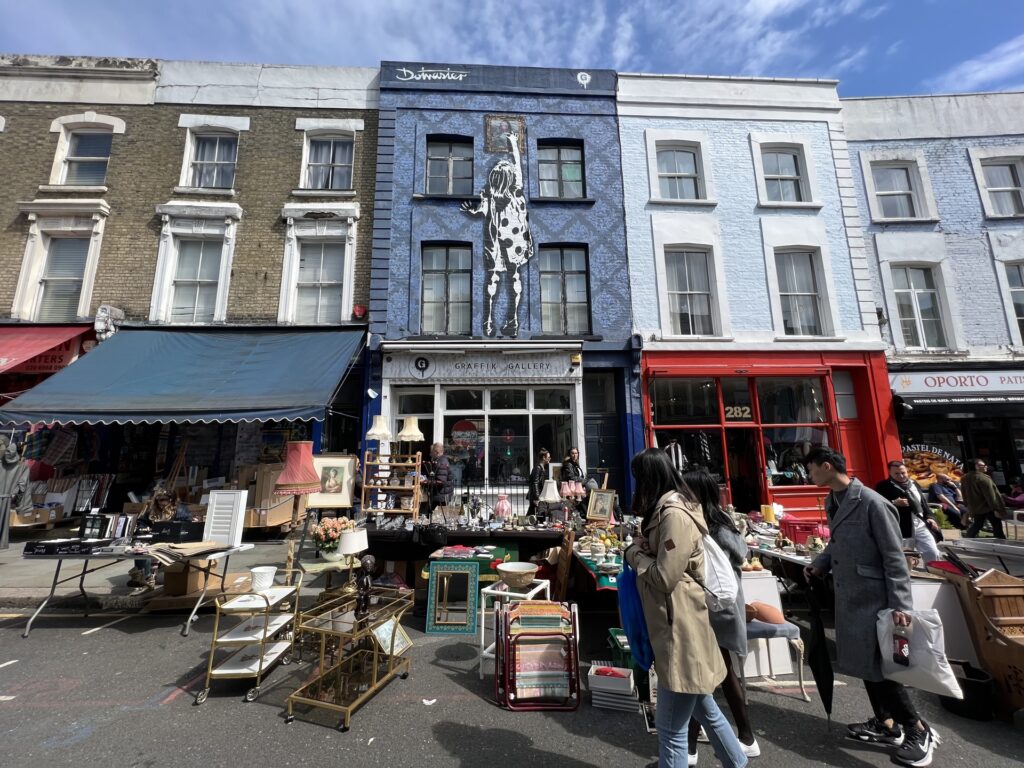
I wasn’t even planning to actually buy anything, but I found myself scoring the racks of a thrift stand, sifting through old ceramic tea cups, and of course, I couldn’t help but buy a hand-embroidered hair bow (okay, three) to add to my collection. If I was hungry for lunch, I definitely would have gotten some street food around Acklam Road.
The market itself was a sight to behold. It was noisy and crowded and hectic and I loved it. But more than that, I loved how the chaotic market balanced with the quaint streets around it. I loved getting swept up in a the crowds for a block or two, then slipping down a side street to enjoy a quiet residential street. I loved that the market brought me to Portobello Road, but it was the colorful streets around it that brought me the most joy.
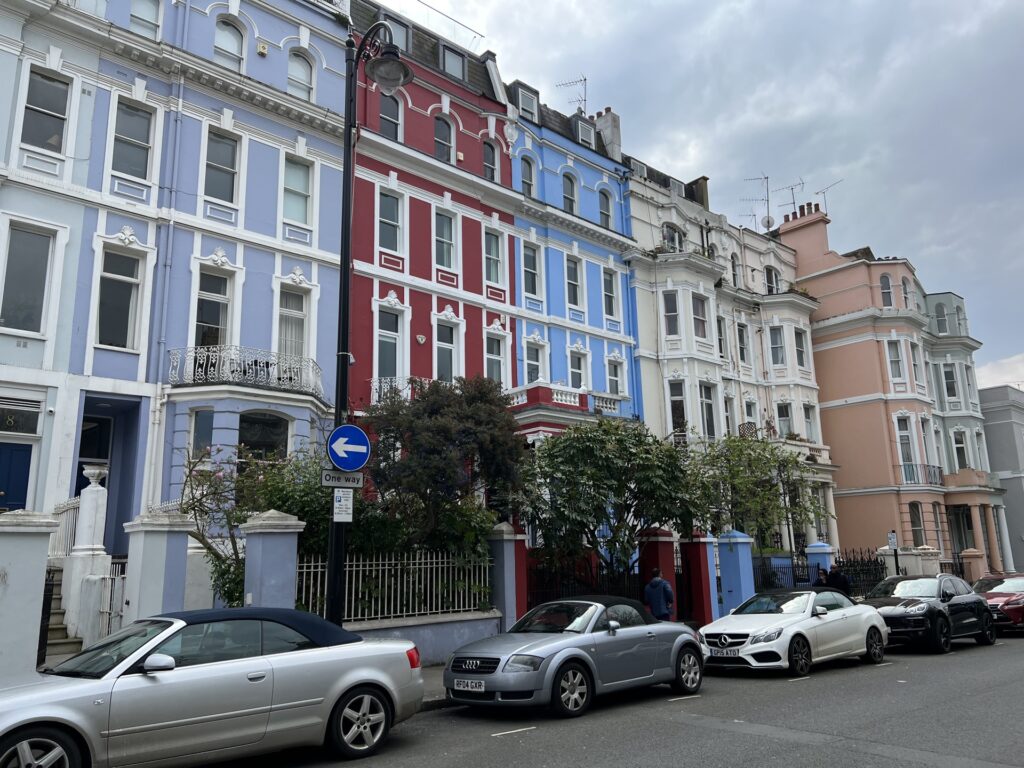
The Colorful Streets of Notting Hill
Speaking of colorful streets, Notting Hill is full of them! The neighborhood is famous for its pastel homes and brightly colored store fronts, and it was every bit as beautiful as I imagined it would be.
While the entire neighborhood isn’t colorful, I was pretty surprised by just how many strips of colorful houses and shops that I found. There were a few side-streets that I intentionally sought out, but many of them I just stumbled upon.
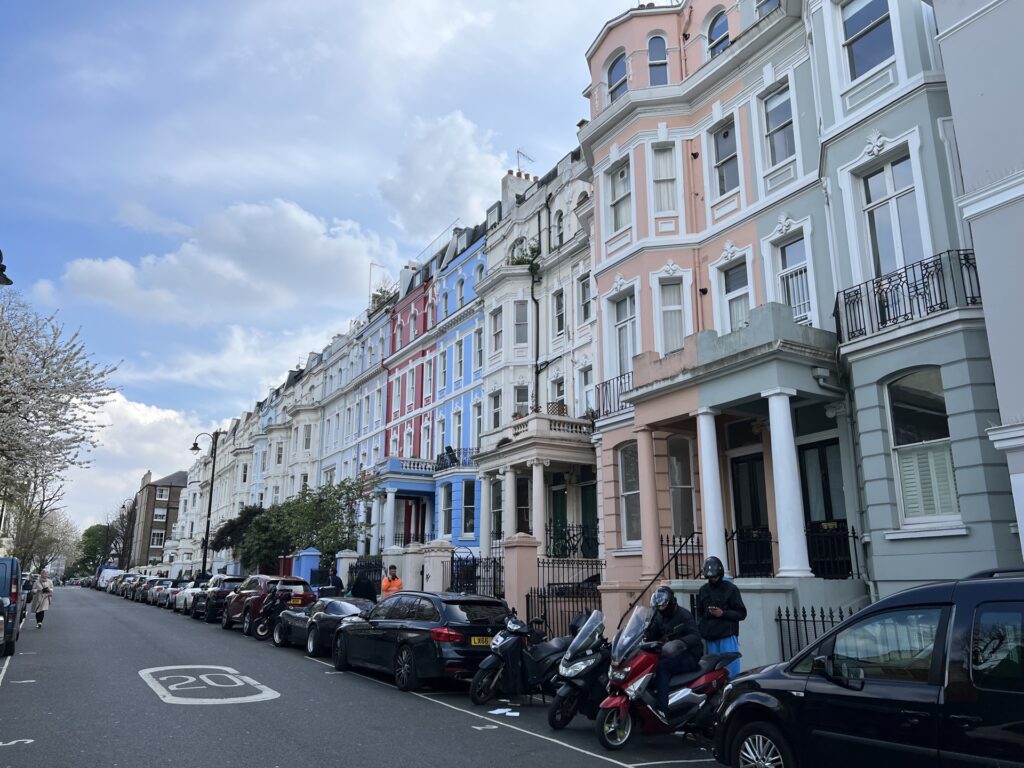
Here is a list of some of my favorite spots for colorful houses in Notting Hill. (I also have them noted in yellow on my map below. If you click on each yellow icon on the map, you can see a photo from that specific street.)
- Westbourne Grove & Ledbury Road
- Courtnell Street & Artesian Road
- Portobello Road, across from Portobello Court
- Portobello Road, across from Denbigh Terrace
- Colville Road, between Lonsdale Road & Colville Terrace
- Colville Terrace, between Colville Road & Portobello Road
- Elgin Crescent, between Portobello Road & Ladbroke Grove
- Westbourne Park Road, between Portobello Road & Clydesdale Road
- St. Luke’s Mews, between All Saints Road & St. Luke’s Road
- Lancaster Road, between All Saints Road & Portobello Road
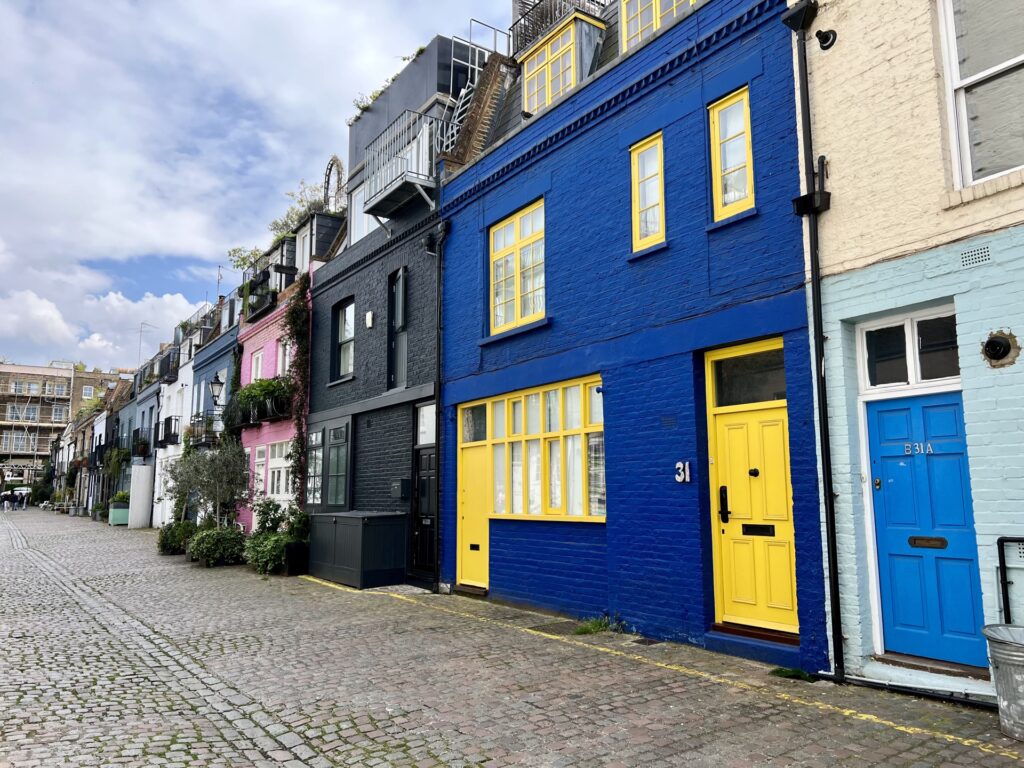
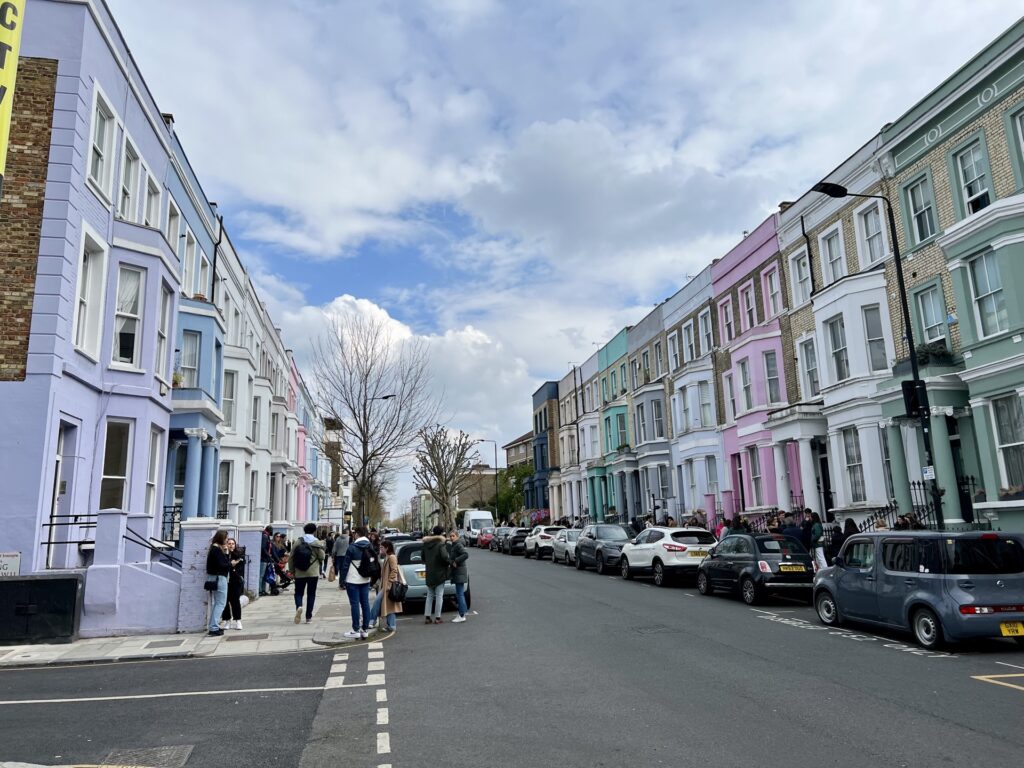
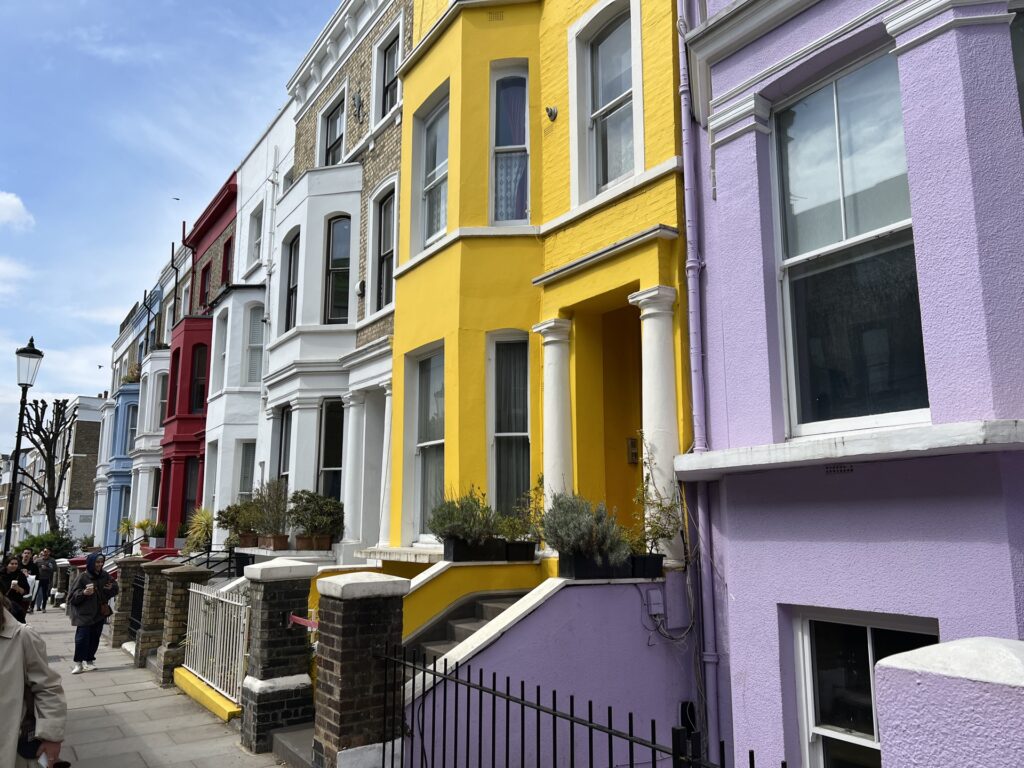
Notting Hill Movie Locations
I only watched Notting Hill for the first time a mere 12 hours prior to stepping foot in the neighborhood. I’m not a die-hard fan nor an expert on the film, but I will jump on any bandwagon that involves a bookshop. Of course I had to visit a few of the iconic filming locations while I was in Notting Hill.
First up, was of course the bookshop. In the movie, the bookshop’s location is 142 Portobello Road. There isn’t now, nor has there ever been, a bookshop at that exact location. It was an antique shop at the time, but it has since been converted to a souvenir shop that is called “The Travel Book Shop.”
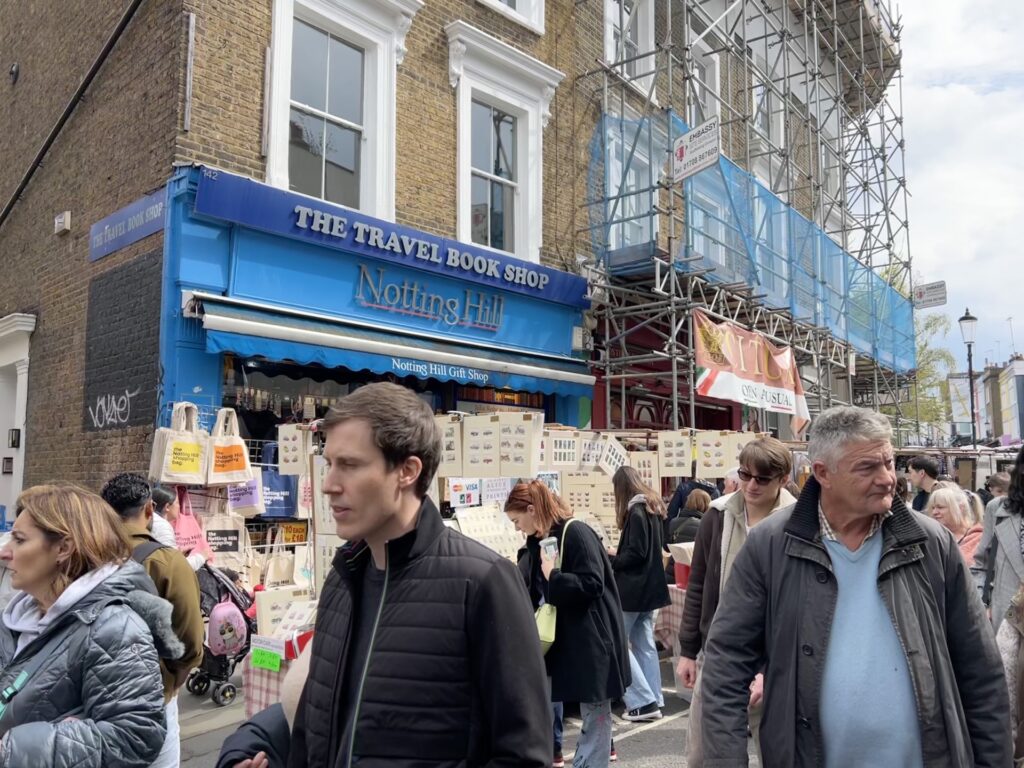
The inspiration for the bookshop in the film was a real bookshop around the corner at 13 Blenheim Crescent, that was actually called The Travel Bookshop. That bookshop closed in 2011, but it later reopened in the same location with new owners under the name The Notting Hill Bookshop. This bookshop still stands, still sells books (though now it sells more than just travel books), and is just as popular as ever.
The inside of the shop was lovely, and I bought a tote and a Paddington book for my toddler. The outside of the shop was much more popular. It was full of people taking photos of the iconic sign and coming in and out of the bookshop door. I really enjoyed standing across the street and watching the crowds ebb and flow.
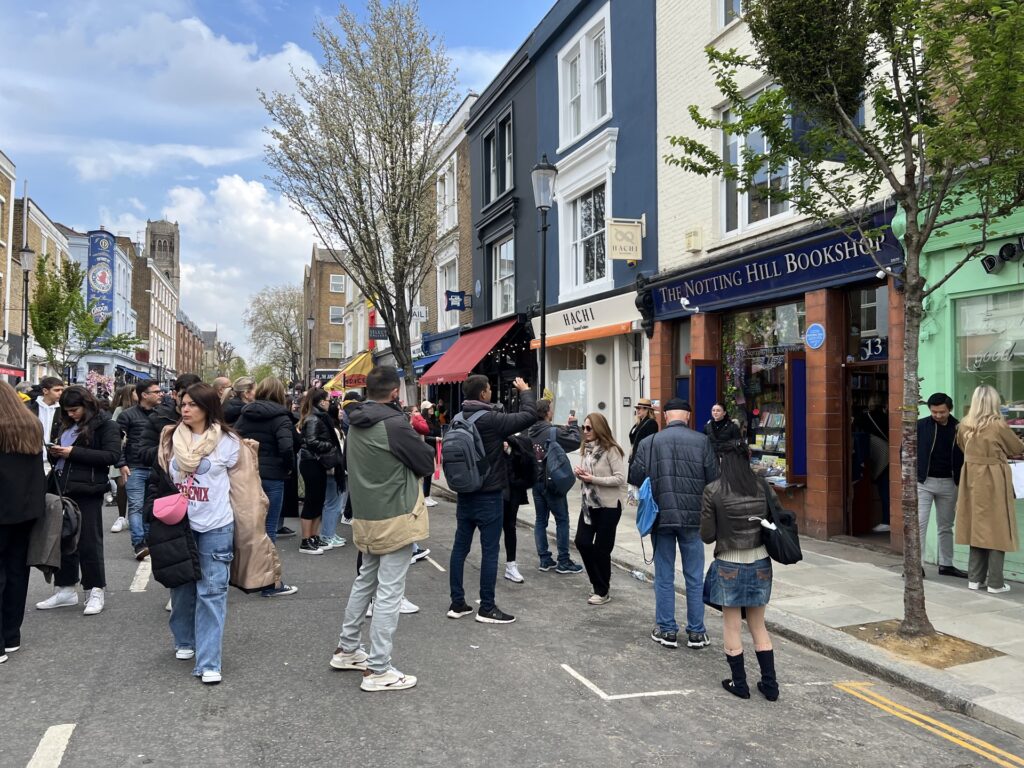
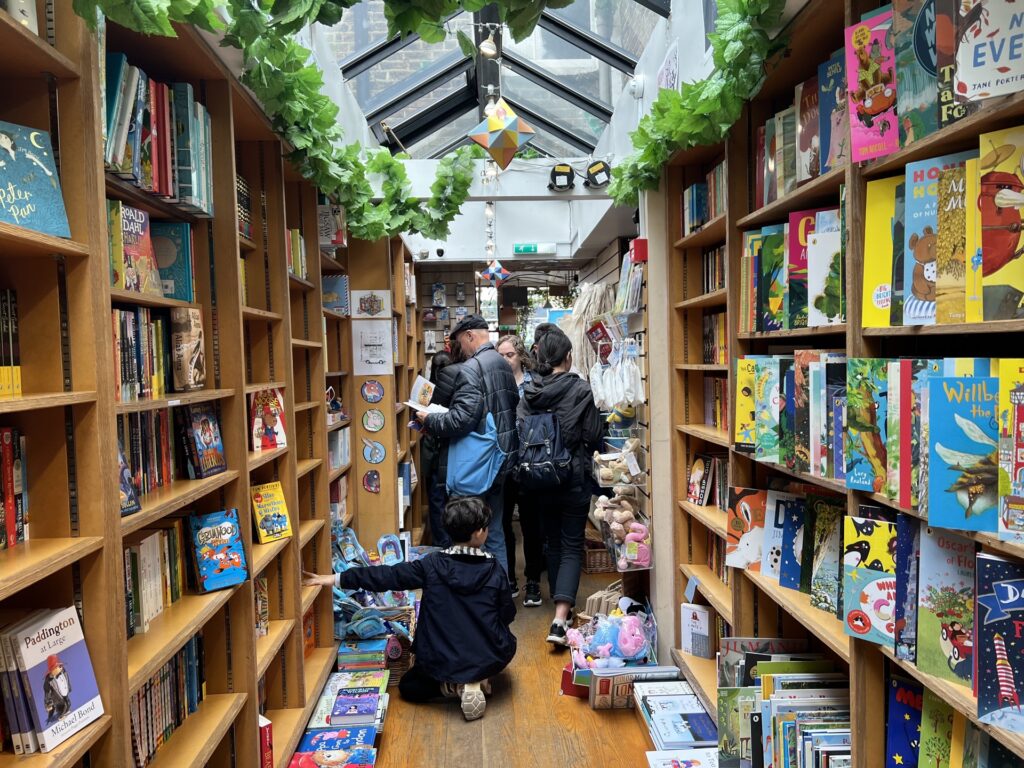
My next stop was the famous Blue Door. While the blue door still exists and is still blue (though I have read that it was painted black for a stint), it is just a door. It of course had a group of tourists taking photos, but it was otherwise unimpressive.
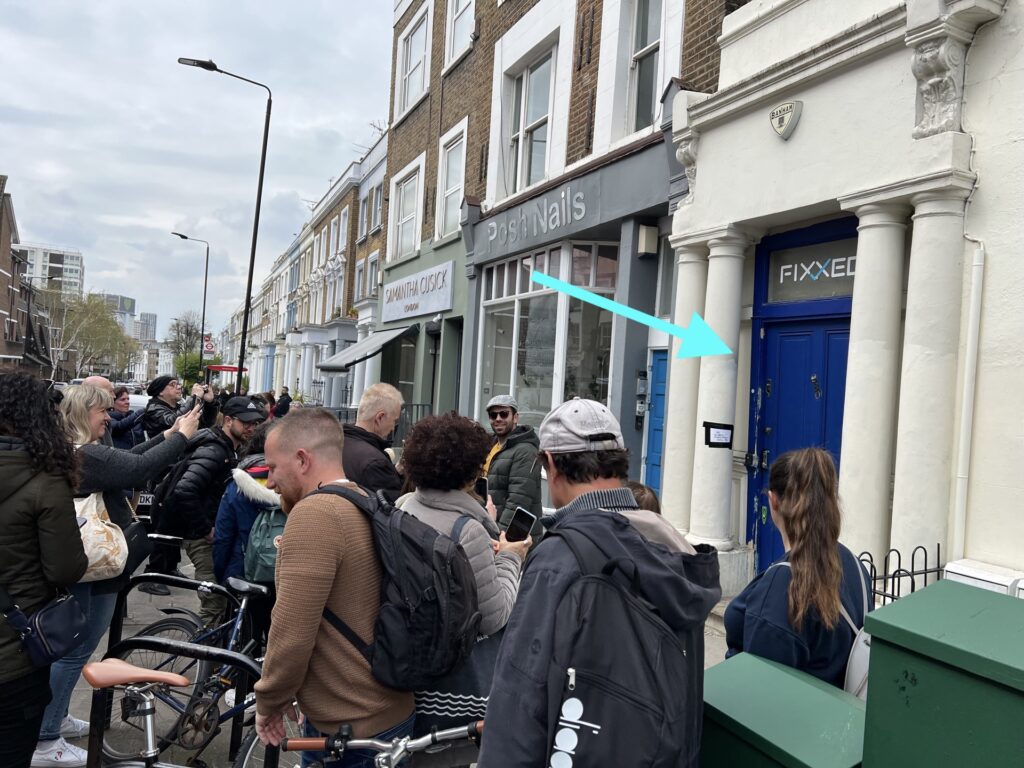
There are the only two movie spots I sought out, but I marked them on my map below. For a few more film locations, be sure to check out this post by Solo Sophie.
South of Portobello Road
I walked Portobello Road for about a mile from Westbourne Grove to Chesterton Road. After that, I turned around and walked all the way back to where I started and then went the other way down Portobello Road (south).
Portobello Road south of Westbourne Grove is no longer a market per say. On Saturday, the road was still blocked to vehicle traffic, but there were not stalls or vendors. This end of the street was lined with antique shops, some with goods spilling out onto sidewalks.
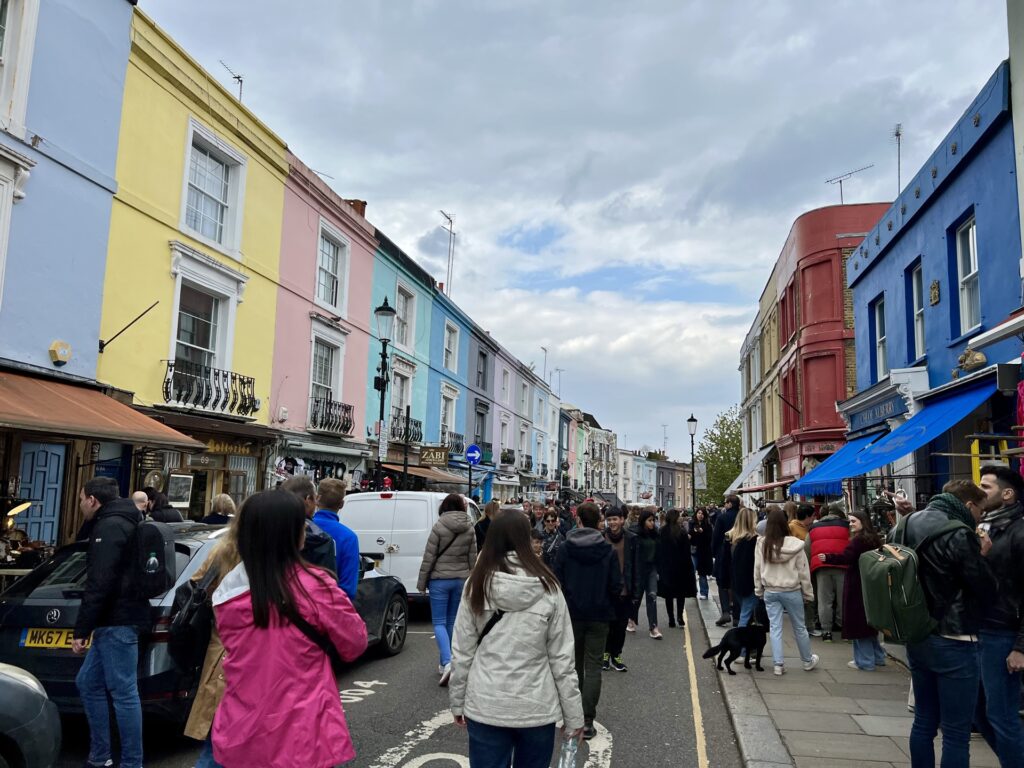
This was one of the prettier stretches of Portobello Road, and was much less crowded than the rest of the market on the other side of Westbourne Grove. I didn’t go into the antique shops — I was pretty exhausted by this point, but also antiques aren’t really my thing — but it was lovely to walk through.
Portobello Road ended at Pembridge Road, which lead me right back to the Tube station I started at. I had walked well over 6 miles (not my best decision for the day before a marathon) and had the most wonderful time!
Notting Hill Walking Map
I’ve plotted my exact route through Notting Hill on the map below. This route includes the main streets in Notting Hill, but also a handful of the smaller streets that I really enjoyed. I also added pins for some of my favorite food and drink stops (purple), movie locations (green), and some of the prettiest houses and shops (yellow).
This walking route is about 4 miles in full. However, it could easily be longer or shorter than that based on your preferences.
A few tips for using this map
- Click on the icon in the map to view its details. (If you click on the yellow icons which indicate colorful facades, you can see a photo of the view from that specific street.)
- To view the map in Google Maps, click the expand icon on the top right corner.
- From the expanded view, you can check/uncheck the boxes for each layer to customize your view.
- Click the star icon to save the map to your Google account for later.
- To access the map next time, open Google Maps > click the Saved tab > click Maps.
Tips for Visiting Notting Hill
- Make a dining reservation. There are lots of great restaurants on Westbourne Grove and around Notting Hill. However, many are small and very popular. If you’re visiting on a weekend, try to make a reservation a few weeks in advance. Alternatively, arrive early or just plan on waiting a bit.
- Visit in the Spring. Notting Hill is surely beautiful all year, but it was extra special in Spring. The streets were lined with flowering trees, the sidewalks were filled with people dining al fresco, and the pastel buildings set the perfect Spring scene.
- … Or visit during Carnival. Another great time to visit is in August, when Notting Hill hosts an annual Caribbean Carnival festival. Going strong since 1966, the festival is now one of the largest street festivals in the world. This is a great way to learn about and experience the Caribbean roots of Notting Hill.
- Zig-zag down Portobello Road. Walking Portobello Road Market in a straight shot can be a bit overwhelming, especially on a Saturday. I’d recommend going a block or two down Portobello Road, then a block or two down a side street, and back again. It will take longer, but you’ll get to see the beautiful homes and enjoy a balanced pace.
- Use the public bathrooms. If you need to use the loo while you’re exploring Notting Hill, you’re in luck! There are several clean and safe public bathrooms around Notting Hill, including every few blocks on Portobello Road. You can search “Public Toilet” in Google Maps, or they are clearly labeled at street level.
- Plan for crowds. Saturday is the busiest day at Portobello Road Market, followed by Friday. (The market is closed on Sunday.) If you don’t like crowds, I’d highly recommend visiting during a weekday or getting there very early.
- Be respectful. Don’t forget that people live in those beautiful, colorful homes. You can take photos from the sidewalk, but do not trespass, leave your trash, or otherwise disturb the area or homes.
- Pair it with Little Venice and Camden Market. The north end of Portobello Road Market is only about 15 minutes by Tube to the Little Venice neighborhood. From there, you can take a canal boat from Little Venice to Camden Market. This combination of activities makes for a busy and fun-filled day in London!
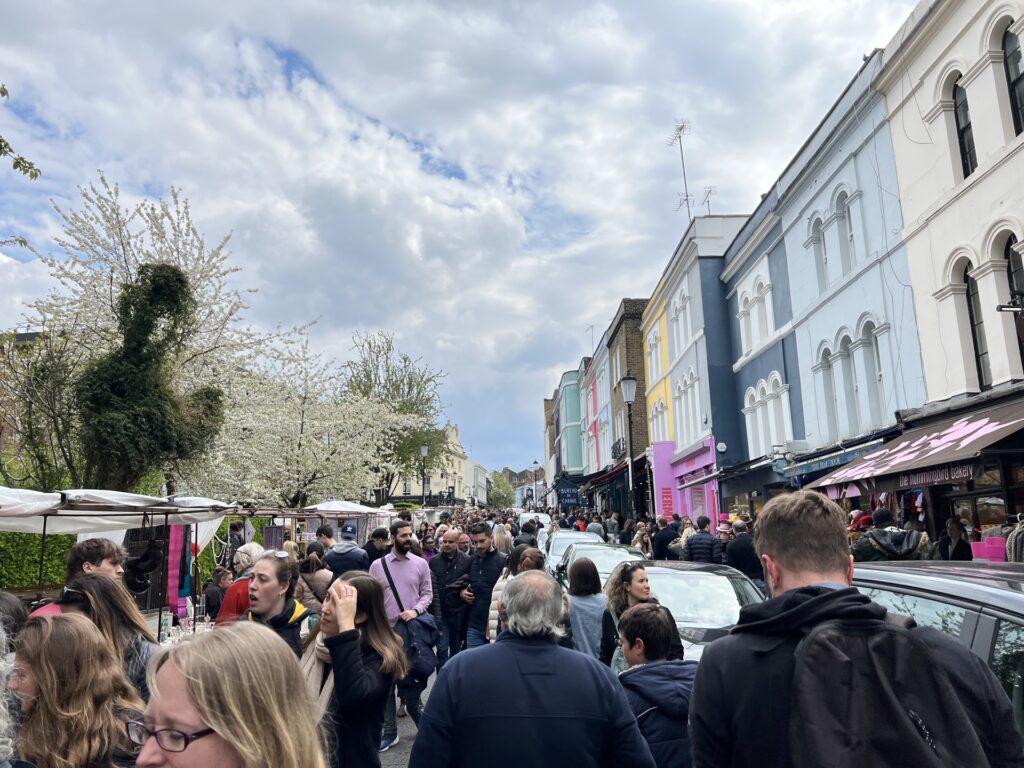
Other London Posts
- London Travel Guide
- Things to do in London with Kids — Family Travel Guide + Tips
- How to Use the London Underground — A Beginner’s Guide to the Tube
- How to Take Uber Boat in London
- Little Venice London Boat Ride Guide & Review
- Borough Market Visitor Guide
- Complete Guide to Big Ben in London
- London Eye Visitor Guide — How to Visit the Iconic Ferris Wheel in London
- Visiting London Transport Museum
- Stonehenge Visitor Guide + Inner Circle Tour Review
- International Traveler’s Guide to the London Marathon
